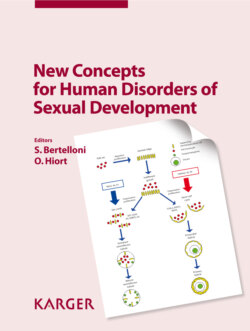Читать книгу New Concepts for Human Disorders of Sexual Development - Группа авторов - Страница 27
На сайте Литреса книга снята с продажи.
Leydig Cells
ОглавлениеLeydig cells constitute another crucial testicular cell lineage in the developing male. They originate from steroidogenic precursor cells immigrating from the coelomic epithelium and the mesonephric mesenchyme to colonise the indifferent gonad [Merchant-Larios and Moreno-Mendoza, 1998; Schmahl et al., 2000; O'Shaughnessy et al., 2006]. At week 7 pc of human development, they start to differentiate. The differentiation and proliferation of functional Leydig cells is influenced by signals from Sertoli cells, as AMH, desert hedge hog (DHH) and FGF9 (for details see online suppl. table 1). [Clark et al., 2000; Colvin et al., 2001a].
Leydig cells may be classified into 3 different subtypes according to their morphological and maturational stage of development. The development and function of human fetal-type and the adult-type Leydig cells were discussed recently in a review by our group [Svechnikov et al., 2010]. The first Leydig cell type to appear after testis determination is the fetal type. It shows a different steroidogenic pattern and regulation as compared with the immature-type and the adult-type Leydig cells. Both other Leydig cell types appear postnatal before puberty and in adults after completed pubertal development, respectively [Ge et al., 1996; Colvin et al., 2001a]. At the 8th week of human gestation, fetal-type Leydig cells start to produce testosterone and other androgens [Svechnikov et al., 2010]. Initially they are regulated by the placental human chorionic gonadotropin (hCG), which shares on Leydig cells signalling receptors with pituitary LH. However, this latter hormone appears much later in development when the HPG axis becomes established in the beginning of the 2nd trimester of human pregnancy. At mid-gestation they may constitute 40% of the total testicular cell mass. Leydig cells are situated in the interstitial tissue compartment of the testis and increase their number during the first 2-3 months after birth [Svechnikov et al., 2010].
Additionally to testosterone, a crucial hormone for differentiation of male external and internal genitalia, Leydig cells also produce SF1 necessary for steroidogenesis [Achermann et al., 2002] and insulin-like factor-3 (INSL3) (online suppl. table 1). INSL3 and its receptor RXFP2, together with androgens and AMH are involved in the process of testicular descent (online suppl. table 1). The first transabdominal phase of testicular descent occurs in human fetuses during week 8-16. Even if LOF mutations affecting INSL3 or RXFP2 result in cryptorchidism, it remains a rare cause of this common malformation in boys [Ivell and Hartung, 2003; Ferlin et al., 2006; online suppl. table 1]. In addition to its important role behind testicular descent, INSL3 seems to have other functions as a paracrine mediator in the male gonad and may also serve as a useful differentiation marker of Leydig cells in clinical practice [Ferlin et al., 2006].
As discussed already in a recent review of our group [Söder, 2007], adrenocortical and gonadal steroidogenic cells seem to share embryonic origin in the coelomic epithelium and may exist as one lineage before divergence into the gonadal and adrenocortical paths [Mesiano and Jaffe, 1997]. In line with this, adrenocortico-tropic hormone (ACTH) has been implicated as a regulatory factor for fetal Leydig cells expressing ACTH receptors in the early phase of gonadal differentiation. A common origin is also supported by the testicular adrenal rest tumours that are often found in male patients with congenital adrenal hyperplasia. These benign tumours are thought to be due to ACTH-driven expansion of adrenocortical or steroidogenic common precursor cells present in the testis [Stikkelbroeck et al., 2001], and, although much rarer, adrenal rest tumours have also been found in the ovary [Claahsen-van der Grinten et al., 2006].
In a similar way to Sertoli cells, Leydig cells represent an obvious target of disruptive actions of xenobiotics and EDCs [Söder, 2007]. In adult animals, these cells demonstrate a large regenerative capacity. Several growth factors have been implicated in Leydig cell regeneration and survival [Yan et al., 2000; Colón et al., 2007]. If this regeneration is driven by the resident Leydig precursor cells is not yet clearly defined. A second possible hypothesis suggests that peritubular testis cells (see below) also represent a reserve pool of steroidogenic cells.
